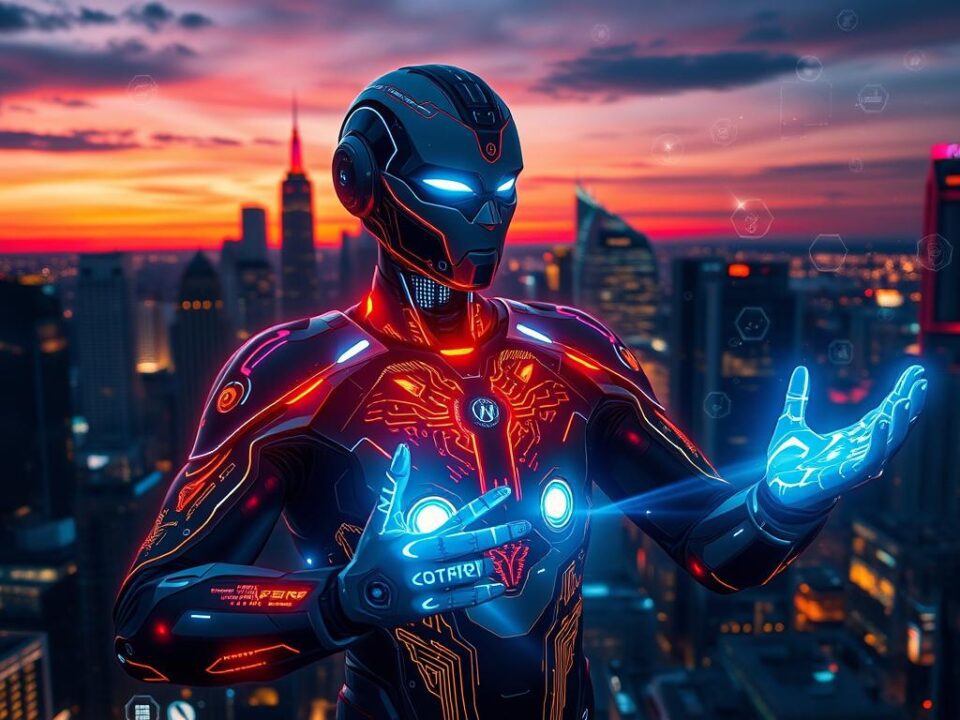In the 1980s, “Knight Rider” was a hit TV show in America. It showed how artificial intelligence (AI) could help in law enforcement. Michael Knight and his AI car, K.I.T.T., were the stars, showing AI’s potential in fighting crime.
Now, AI is being used in real life to fight crime. This idea from “Knight Rider” is becoming a reality.
Today, the world is more digital than ever. Criminals use technology to commit crimes. But, the same tech can also help fight crime.
AI-powered tools, like K.I.T.T., are now helping law enforcement. They are a powerful tool in the fight against crime.
Understanding AI in Crime Prevention
AI technology in law enforcement has evolved a lot since K.I.T.T. in Knight Rider. Now, modern AI is changing how police fight crime and solve mysteries.
Recent stats show AI algorithms are quickly and effectively helping police understand crime patterns. AI helps police use data to find the best ways to prevent crime. It also helps them see which programs work best worldwide.
AI is key in deciding how to use resources for crime prevention. It helps police find the most effective strategies by analyzing crime patterns. For example, in Chicago, AI helped reduce robberies, burglaries, and car thefts by a lot.
“The collaboration between traditional AI and Generative AI in crime investigation work offers opportunities for more effective crime prevention and detection strategies.”
Generative AI is making law enforcement even better at analyzing big data. It helps police spot risky behaviors and find potential threats. This new tech aims to make our society safer and more secure.
But, using AI in law enforcement raises ethical questions. There are worries about bias and fairness. For example, facial recognition mistakes have hurt certain groups like women and Black men. As AI becomes more common, it’s vital to ensure it’s used fairly and ethically.
How AI Crime Fighters Work
AI systems are becoming key allies for police in the fight against crime. Like K.I.T.T. from Knight Rider, they use advanced data analysis to help officers. This makes them powerful tools in the battle against crime.
These AI systems gather and sort through huge amounts of data. They look at past crimes, social trends, and even weather. They use this info to predict where crimes might happen next and improve surveillance, giving police an edge.
AI changes how police work by analyzing CCTV footage and finding connections between crimes. It’s great at facial recognition, helping catch suspects fast. It also helps solve old cases by looking at evidence again.
But AI does more than just solve crimes. It helps prevent them too. It watches social media for threats and checks who might commit crimes again. It even spots security risks before they happen.
“AI crime fighters are not just passive observers – they actively collaborate with human officers, providing them with the insights and tools they need to stay one step ahead of the criminals.”
AI is becoming more important in fighting crime. It uses data and analytics to keep us safe. It’s making our communities safer and more secure.
- AI crime fighters collect and analyze vast amounts of data, similar to how K.I.T.T. processed information in Knight Rider.
- They use predictive policing algorithms to forecast potential crime hotspots and enhance real-time surveillance capabilities.
- AI-based facial recognition helps identify suspects in real-time from CCTV footage.
- AI tools for data analysis efficiently link suspects, victims, and crime scenes.
- AI systems can detect unusual patterns in network traffic, improving threat detection and response time.
The abilities of AI crime fighters are amazing. But we must think about their use, like privacy and fairness. As AI grows, we must make sure it’s used right. It must help keep justice and fairness for everyone.
Benefits of AI in Crime Fighting
Artificial intelligence (AI) is a powerful tool in crime fighting, similar to K.I.T.T. in Knight Rider. It boosts efficiency in investigations and helps prevent crimes. It also improves how resources are used.
AI can quickly and accurately analyze huge amounts of data. Only 2% of flagged transactions by current systems show true crimes. But AI helps banks file 20 times more reports on money laundering, cutting false alerts in half. PayPal has also reduced its false alerts by half with AI.
AI can spot suspicious patterns that experts might miss. The Royal Bank of Scotland stopped over $9 million in losses with AI for small business transactions. This makes AI crucial in fighting financial crimes and money laundering.
AI is also used to improve counterterrorism and fight human trafficking. It helps detect illegal goods in express delivery. Public-private partnerships are forming to fight crime with AI. For example, the UK’s National Crime Agency works with UK Finance to fight financial crimes and human trafficking.
AI works faster and more accurately than humans. AI algorithms predict crime patterns, helping police prevent crimes. It ensures law enforcement uses resources effectively for crime prevention.
While AI in crime fighting has many benefits, ethical concerns must be addressed. Companies should test AI models against simpler ones to avoid biases. This ensures AI is transparent and fair in crime detection.
“AI enables companies to surface suspicious patterns or relationships invisible even to experts by linking millions of data points from different databases.”
Challenges Facing AI Crime Fighters
AI technologies are getting better and could help fight crime. But, there are big challenges to overcome. One major issue is privacy. AI tools like surveillance and predictive analytics make us wonder if safety and privacy can coexist.
Another big problem is bias in AI. Like any tech, AI can show biases, unfairly targeting some groups. This is especially serious in criminal justice, where wrong decisions can have big consequences.
Using AI with old-school policing is also tough. It needs careful planning and teamwork between tech experts and police. This ensures AI tools fit in smoothly with police work.
“The ethical dilemmas of using AI in law enforcement are complex and multifaceted. We must ensure that these powerful technologies are deployed responsibly and with due consideration for the rights and well-being of all citizens.”
These hurdles show the deep ethical questions around AI in criminal justice. As AI crime fighters grow, it’s key for everyone to work together. This way, we can enjoy AI’s benefits while avoiding its downsides.
Success Stories of AI in Action
AI is making a big difference in fighting crime. It works well with human officers, just like Michael Knight and K.I.T.T. in Knight Rider. Together, they solve tough cases.
In cybersecurity, 34% of companies use AI tools to fight threats from generative AI. Microsoft’s Microsoft Copilot for Security shows how AI helps in the battle against cybercrime.
AI facial recognition is better than humans at identifying faces. It saves time by quickly matching images. Over 60 countries use this tech, leading to fewer violent crimes.
Predictive policing software like PredPol in New York City has cut crime by up to 10%. It spots patterns and predicts crime hotspots. Delivery companies also use AI to spot banned items in packages.
Banks and police work together to spot fake goods and money with AI. Medicine and retail use AI to catch suspicious customers. Shipping companies fight human trafficking by checking containers with AI.
These stories show AI’s huge potential in fighting crime. As AI and humans team up more, we’ll see even more amazing results.
“AI technology serves as an amplifier of people’s intentions and visions for the future of humanity in both positive and negative ways.”
The Role of Machine Learning
Machine learning is key in making AI crime fighters better. These systems use advanced algorithms to study huge datasets. This helps them spot patterns, predict crimes, and give police useful tips.
At the University of Leon in Spain, researchers are training AI on thousands of crime scene photos. This lets the AI find important clues for investigations. Also, AI is making police work cheaper by doing tasks like watching crime footage and looking at evidence files.
Facial recognition, powered by machine learning, is becoming common in law enforcement. It helps find suspects online and in person. These AI systems also link data points, giving police useful info for their cases.
“As artificial intelligence advances and is refined, there will be a potential for machines to solve crimes beyond a reasonable doubt, creating safer communities and reducing the chances of innocent people being wrongly accused.”
But, using machine learning in crime fighting has its hurdles. The use of secret software can lead to legal problems, as courts might ask for the algorithms’ details. Also, teaching AI to look at tiny evidence is expensive and takes a lot of time. The algorithms must be able to tell apart particles from different people.
Despite these issues, machine learning’s role in fighting crime is huge. As it gets better, it will greatly help police solve cases more quickly and well.
Ethical Considerations in AI Crime Fighting
As crime fighting AI and advanced tech grow in law enforcement, ethics become key. It’s a tightrope between keeping people safe and respecting privacy. Setting clear ethical rules for AI in crime fighting is vital, echoing debates in shows like Knight Rider.
Intelligence agencies worldwide see AI as a game-changer. The UK’s GCHQ says “AI will be central to protecting the UK” (GCHQ, 2021). The USA’s National Security Commission on Artificial Intelligence agrees, saying “AI will change intelligence work” and “AI is perfect for intelligence tasks” (NSCAI, 2021).
But, using AI in crime fighting also stirs up worries. Issues like bias, privacy, and clear decision-making are big concerns. AI systems might unfairly target some groups, hurting justice. Also, unclear AI algorithms make it hard for people to defend themselves in court.
- The field of augmented intelligence analysis is rapidly growing due to advancements in AI technology, such as machine learning and deep learning.
- AI is used in many fields like defense, counterterrorism, and policing.
- Predictive policing uses AI algorithms to guess crimes before they happen, based on data like crime stats and social media.
As crime fighting AI evolves, it’s essential for everyone to work on ethics. Finding a balance between safety and privacy will be tough. But, it’s crucial for justice and fairness.
“All U.S. companies audited have stopped selling facial recognition tech to law enforcement, to some extent, since the Gender Shades study came out.”
– Dr. Joy Buolamwini, Founder of the Algorithmic Justice League
Public Perception of AI Crime Fighters
AI is becoming more common in law enforcement, and how people see AI crime fighters matters a lot. Some think AI can help prevent and solve crimes better. But, others worry about AI’s reliability, bias, and how it affects privacy.
Many people don’t trust AI or the police using it. Stories about AI leading to wrong arrests, denying help, or showing racial bias have made people doubt. It’s important to be open and involve the community to gain trust in AI crime fighters.
“AI should be a tool that enhances policing, not replaces human judgment and discretion. Maintaining trust in law enforcement is critical, and that requires being upfront about the capabilities and limitations of these technologies.”
Just like Knight Rider made people understand AI in law enforcement, education and talking openly can help. By talking about the good and the bad, people might start to see AI as a helpful tool for safety.
As AI crime fighters become more common, it’s key for police, lawmakers, and tech companies to work together. They must make sure AI is used fairly, openly, and with the community’s trust. This way, AI can really help fight crime.
Future Innovations in AI Crime Fighting
The world is getting more connected, and crime fighting is set to see big changes with AI. Imagine a future where AI can stop crimes before they happen, like the superhero AI in Knight Rider.
New tech like machine learning and natural language processing is changing how police fight crime. They can now catch financial fraud more easily, thanks to AI that’s 96% accurate.
AI is also helping police catch criminals faster. For example, Walmart saw a 25% drop in shoplifting with AI video analysis. The NYPD solved a rape case in just 24 hours with facial recognition.
The future of AI in crime fighting looks even brighter. Imagine smart cities working with police to stop crimes before they start. This idea, once just in sci-fi, is now becoming real.
“The future of crime fighting is not about brute force, but rather about the power of technology to outsmart and outmaneuver the criminal element. AI-powered crime fighters are the superheroes of tomorrow, safeguarding our communities with unparalleled precision and efficiency.”
Looking ahead, AI’s role in fighting crime will grow, changing how we keep our communities safe. Our cities will be safer for everyone.
Government Regulations and AI
AI technology is advancing fast, and governments are trying to keep up. They want to make sure AI is used right in law enforcement. In the U.S., laws about AI in crime fighting are changing. There’s a need for clear rules to protect people while using AI.
Recently, the U.S. Senate started “AI Insight Forums.” The Department of Homeland Security gave $3.4 million to researchers for AI on social media. But, these moves worry people about privacy and fairness.
The FBI uses AI to find suspects. But, this tech can make mistakes, especially for Black people. It has led to wrong arrests and jail time.
“The oversight board overseeing Meta (Facebook) algorithms requires access to the algorithms to effectively fulfill its responsibilities.”
Now, there’s a push for better oversight and rules for AI in crime fighting. Experts say we need a new board to watch over AI in law enforcement. This would help make sure AI is used right.
To use AI well in fighting crime, we need a balance. Policymakers, law enforcement, and tech companies must work together. They should make rules that keep trust, protect privacy, and use AI fairly.
Collaboration Between Tech Companies and Police
In the fight against crime, tech companies and police are teaming up to create new AI tools. This partnership is like the one between FLAG and Knight Industries in Knight Rider. They used advanced tech to help law enforcement.
Knightscope Inc. is leading this tech charge. Their robots can gather up to 90 terabytes of data each year. This data helps improve predictive policing, used by many law enforcement groups worldwide.
Axon Enterprise Inc. has moved from making stun guns to focusing on AI and machine learning for police. Palantir Technologies Inc., started by the CIA, also helps with predictive policing. They work with agencies like the New Orleans Police Department.
The security industry spends about $500 billion yearly on security. This shows the big market for companies like Knightscope and IBM. IBM’s IBM Digital Policing Platform uses AI and cloud tech to help police.
“The collaboration between tech companies and police departments is driving remarkable innovations in AI-powered crime-fighting capabilities.”
The partnership between tech and police is key in fighting crime. With these advanced tools, police can use crime fighting AI and superhero tech to protect communities.
Getting Involved with AI in Law Enforcement
Citizens can help a lot as AI fights crime. By working with local police, people can help make AI tools better. This helps solve crimes more effectively.
Getting involved is easy. You can learn about AI in law enforcement through educational programs. These programs teach about AI’s good and bad sides in fighting crime. By joining town hall meetings and forums, you can share your thoughts and help shape AI policing.
If you want to do more, there are new jobs in AI law enforcement. You can be a data analyst or AI designer. These jobs let you use your tech skills to help your community. It’s a chance to make a difference.







